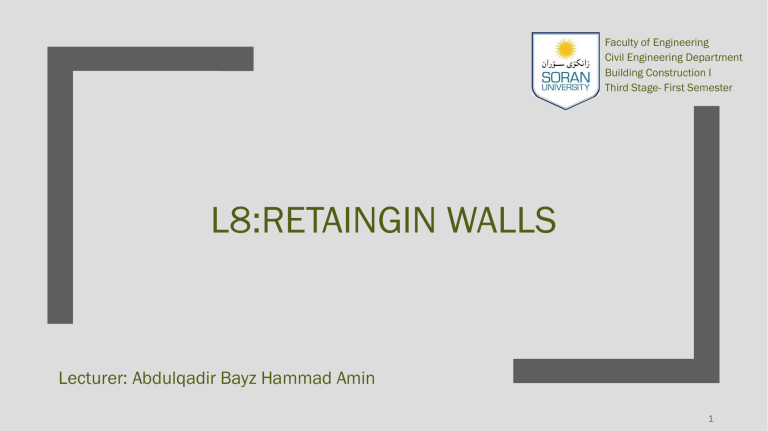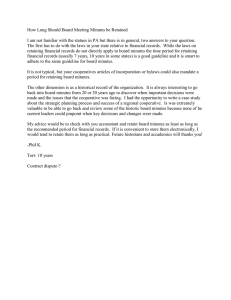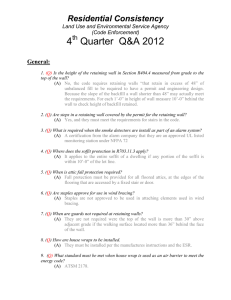
Faculty of Engineering Civil Engineering Department Building Construction I Third Stage- First Semester L8:RETAINGIN WALLS Lecturer: Abdulqadir Bayz Hammad Amin 1 Retaining wall ■ When a desired change in ground elevation exceeds the angle of repose of the soil, a retaining wall becomes necessary to hold that the mass of earth on the uphill side of the grade change. ■ A retaining wall must be designed and constructed to resist lateral pressure of the soil being retained. This active pressure increases proportionally from zero at the upper grade level to a maximum value at the lowest depth of the wall. The total pressure or thrust may be assumed be acting through the centroid of the triangular distribution pattern, one-third above the base of the wall. 2 Retaining walls 3 RETAINING WALLS 4 Retaining wall T= 0.286 * SH2/2 T= Total pressure or thrust S= weight of retained soil; 100 pcf (1600 kg/m3) W= composite weight of wall acting through centroid of the section R= resultant of T and W 5 6 7 • Retaining Walls ~ the major function of any retaining wall is to act as an earth-retaining structure for the whole or part of its height on one face, the other being exposed to the elements. Most small height retaining walls are built entirely of brickwork or a combination of brick facing and blockwork or mass concrete backing. To reduce hydrostatic pressure on the wall from ground water an adequate drainage system in the form of weep holes should be used. Alternatively subsoil drainage behind the wall could be employed. 8 Retaining Walls up to 1m High (2) Small Height Retaining Walls ~ retaining walls must be stable and the usual rule of thumb for small height brick retaining walls is for the height to lie between two and four times the wall thickness. Stability can be checked by applying the middle third rule † 9 Medium Height Retaining Walls Retaining Walls up to 6„000 high ~ these can be classified as medium height retaining walls and have the primary function of retaining soils at an angle in excess of the soil's natural angle of repose. Walls within this height range are designed to provide the necessary resistance by either their own mass or by the principles of leverage. 10 Medium Height Retaining Walls Earth Pressures ~ these can take one of two forms, namely: 1 . Active Earth Pressures † these are those pressures which tend to move the wall at all times and consist of the wedge of earth retained plus any hydrostatic pressure. The latter can be reduced by including a subsoil drainage system behind and/or through the wall. 11 Medium Height Retaining Walls Earth Pressures ~ these can take one of two forms, namely: 2. Passive Earth Pressures ~ these are a reaction of an equal and opposite force to any imposed pressure thus giving stability by resisting movement.. 12 Medium Height Retaining Walls Mass Retaining Walls ~ these walls rely mainly on their own mass to overcome the tendency to slide forward. Mass retaining walls are not generally considered to be economic over a height of 1„800 when constructed of brick or concrete and 1„000 high in the case of natural stonework. Any mass retaining wall can be faced with another material but generally any applied facing will not increase the strength of the wall and is therefore only used for aesthetic reasons. 13 Medium Height Retaining Walls Cantilever Retaining Walls ~ these are constructed of reinforced concrete with an economic height range of 1„200 to 6„000. They work on the principles of leverage where the stem is designed as a cantilever fixed at the base and base is designed as a cantilever fixed at the stem. Several formats are possible and in most cases a beam is placed below the base to increase the total passive resistance to sliding. Facing materials can be used in a similar manner to that. 14 Cantilever Retaining Walls 15 Thank you for your Attention 16




